NOTE: October is Blind Awareness Month
By: Heather Holmes, Protactile Language Interpreting National Program co-director; CM Hall, Protactile Language Interpreting National Program co-director; and Kristen Rhinehart-Fernandez, Rehabilitation Services Administration project officer
The Rehabilitation Services Administration (RSA) is working to advance diversity, equity, inclusion, accessibility and systems change through its Training of Interpreters for Individuals Who are Hard of Hearing and Individuals Who are DeafBlind program.
In October 2021, RSA funded seven projects to provide training to working interpreters in specialty areas to develop a new skill area or enhance an existing skill area to effectively meet the communication needs of individuals who are deaf or hard of hearing and individuals who are DeafBlind receiving vocational rehabilitation services and/or services from other programs, such as independent living services, under the Rehabilitation Act of 1973, as amended.
One of the project’s funded is Western Oregon University’s Protactile Language Interpreting (PLI) National Education Program. The program trains sign language interpreters working with DeafBlind consumers who are using a new language, Protactile, in a variety of settings such as vocational rehabilitation, post-secondary education, professional and business-related events, and medical settings.


